Spatial-Temporal Changes of Soil Organic Carbon Content in Wafangdian, China
Abstract
:1. Introduction
2. Materials and Methods
2.1. Study Area
2.2. Collection
2.2.1. Soil Survey Data from 1990
2.2.2. Soil Sampling in 2010
2.2.3. Predictor Variables
2.2.4. Land-Use Data
2.3. Prediciton Model Based on Boosted Regression Trees
2.4. Model Validation
3. Results and Discussion
3.1. Descriptive Statistics of SOC Content
3.2. Model Performance
3.3. Relative Importance of Environmental Variables
3.4. SOC Content Maps and Spatial-Temporal Changes
3.5. Effects of Land-Use Change on SOC Content
4. Conclusions
Acknowledgments
Author Contributions
Conflicts of Interest
References
- Batjes, N.H. Total carbon and nitrogen in the soils of the world. Eur. J. Soil Sci. 1996, 47, 151–163. [Google Scholar] [CrossRef]
- Bohn, H.L. Estimate of organic carbon in world soils: II. Soil Sci. Soc Am. J. 1982, 46, 1118–1119. [Google Scholar] [CrossRef]
- Grace, J. Understanding and managing the global carbon cycle. J. Ecol. 2004, 92, 189–202. [Google Scholar] [CrossRef]
- Lal, R. Soil carbon sequestration to mitigate climate change. Geoderma 2004, 123, 1–22. [Google Scholar] [CrossRef]
- Gal, A.; Vyn, T.J.; Micheli, E.; Kladivko, E.J.; McFee, W.W. Soil carbon and nitrogen accumulation with long-term no-till versus moldboard plowing overestimated with tilled-zone sampling depths. Soil Tillage Res. 2007, 96, 42–51. [Google Scholar] [CrossRef]
- Wiesmeier, M.; Hübner, R.; Spörlein, P.; Geuß, U.; Hangen, E.; Reischl, A.; Schilling, B.; Lützow, M.; Kögel-Knabner, I. Carbon sequestration potential of soils in southeast Germany derived from stable soil organic carbon saturation. Glob. Chang. Biol. 2014, 20, 653–665. [Google Scholar] [CrossRef] [PubMed]
- Zhao, M.S.; Zhang, G.L.; Wu, Y.J.; Li, D.C.; Zhao, Y.G. Driving forces of soil organic matter change in Jiangsu Province of China. Soil Use Manag. 2015, 31, 440–449. [Google Scholar] [CrossRef]
- Mann, L.K. Changes in soil carbon storage after cultivation. Soil Sci. 1986, 142, 279–288. [Google Scholar] [CrossRef]
- Paustian, K.; Andrén, O.; Janzen, H.H.; Lal, R.; Smith, P.; Tian, G.; Tiessen, H.; Van Noordwijk, M.; Woomer, P.L. Agricultural soils as a sink to mitigate CO2 emissions. Soil Use Manag. 1997, 13, 230–244. [Google Scholar] [CrossRef]
- Cruz, F.T.; Pitman, A.J.; McGregor, J.L. Probabilistic simulations of the impact of increasing leaf-level atmospheric carbon dioxide on the global land surface. Clim. Dyn. 2010, 34, 361–379. [Google Scholar] [CrossRef]
- Zhang, F.; Li, C.; Wang, Z.; Wu, H. Modeling impacts of management alternatives on soil carbon storage of farmland in Northwest China. Biogeosciences 2006, 3, 451–466. [Google Scholar] [CrossRef]
- Yin, K.; Lu, D.S.; Tian, Y.C.; Zhao, Q.J.; Yuan, C. Evaluation of Carbon and Oxygen Balances in Urban Ecosystems Using Land Use/Land Cover and Statistical Data. Sustainability 2014, 7, 195–221. [Google Scholar] [CrossRef]
- Qiu, L.F.; Zhu, J.X.; Wang, K.; Hu, W. Land Use Changes Induced County-Scale Carbon Consequences in Southeast China 1979–2020, Evidence from Fuyang, Zhejiang Province. Sustainability 2015, 8, 38. [Google Scholar] [CrossRef]
- McBratney, A.B.; Mendonça Santos, M.L.; Minasny, B. On digital soil mapping. Geoderma 2003, 117, 3–52. [Google Scholar] [CrossRef]
- Jenny, H. Factors of Soil Formation: A System of Quantitative Pedology; Beth, R., Ed.; Soil Science: Philadelphia, PA, USA, 1941; Volume 42, p. 415. [Google Scholar]
- Zhao, M.S.; Rossiter, D.G.; Li, D.C.; Zhao, Y.G.; Yang, J.L.; Liu, F.; Zhang, G.L. Mapping soil organic matter in low-relief areas based on land surface diurnal temperature difference and a vegetation index. Ecol. Indic. 2014, 39, 120–133. [Google Scholar] [CrossRef]
- Brus, D.J.; Yang, R.M.; Zhang, G.L. Three-dimensional geostatistical modeling of soil organic carbon: A case study in the Qilian Mountains, China. Catena 2016, 141, 46–55. [Google Scholar] [CrossRef]
- Marvin, D.C.; Asner, G.P.; Schnitzer, S.A. Liana canopy cover mapped throughout a tropical forest with high-fidelity imaging spectroscopy. Remote Sens. Environ. 2016, 176, 98–106. [Google Scholar] [CrossRef]
- Grimm, R.; Behrens, T.; Märker, M.; Elsenbeer, H. Soil organic carbon concentrations and stocks on Barro Colorado Island-digital soil mapping using Random Forests analysis. Geoderma 2008, 146, 102–113. [Google Scholar] [CrossRef]
- Yang, R.M.; Zhang, G.L.; Liu, F.; Lu, Y.Y.; Yang, F.; Yang, F.; Yang, M.; Zhao, Y.G.; Li, D.C. Comparison of boosted regression tree and random forest models for mapping topsoil organic carbon concentration in an alpine ecosystem. Ecol. Indic. 2016, 60, 870–878. [Google Scholar] [CrossRef]
- Wiesmeier, M.; Barthold, F.; Blank, B.; Kögel-Knabner, I. Digital mapping of soil organic matter stocks using Random Forest modeling in a semi-arid steppe ecosystem. Plant Soil 2011, 340, 7–24. [Google Scholar] [CrossRef]
- Were, K.; Bui, D.T.; Dick, Ø.B.; Singh, B.R. A comparative assessment of support vector regression, artificial neural networks, and random forests for predicting and mapping soil organic carbon stocks across an Afromontane landscape. Ecol. Indic. 2015, 52, 394–403. [Google Scholar] [CrossRef]
- Minasny, B.; Setiawan, B.I.; Arif, C.; Saptomo, S.K.; Chadirin, Y. Digital mapping for cost-effective and accurate prediction of the depth and carbon stocks in Indonesian peatlands. Geoderma 2016, 272, 20–31. [Google Scholar]
- Froeschke, J.T.; Froeschke, B.F. Spatio-temporal predictive model based on environmental factors for juvenile spotted seatrout in Texas estuaries using boosted regression trees. Fish. Res. 2011, 111, 131–138. [Google Scholar] [CrossRef]
- Adhikari, K.; Kheir, R.B.; Greve, M.B.; Greve, M.H. Comparing kriging and regression approaches for mapping soil clay content in a diverse Danish landscape. Soil Sci. 2013, 178, 505–517. [Google Scholar] [CrossRef]
- Skurichina, M.; Duin, R.P. Bagging, boosting and the random subspace method for linear classifiers. Pattern Anal. Appl. 2002, 5, 121–135. [Google Scholar] [CrossRef]
- Elith, J.; Leathwick, J.R.; Hastie, T. A working guide to boosted regression trees. J. Anim. Ecol. 2008, 77, 802–813. [Google Scholar] [CrossRef] [PubMed]
- Friedman, J.H.; Meulman, J.J. Multiple additive regression trees with application in epidemiology. Stat. Med. 2003, 22, 1365–1381. [Google Scholar] [CrossRef] [PubMed]
- Minasny, B.; McBratney, A.B.; Mendonça-Santos, M.L.; Odeh, I.O.A.; Guyon, B. Prediction and digital mapping of soil carbon storage in the Lower Namoi Valley. Aust. J. Soil Res. 2006, 44, 233–244. [Google Scholar] [CrossRef]
- Pouteau, R.; Rambal, S.; Ratte, J.P.; Gogé, F.; Joffre, R.; Winkel, T. Downscaling MODIS-derived maps using GIS and boosted regression trees: the case of frost occurrence over the arid Andean highlands of Bolivia. Remote Sens. Environ. 2011, 115, 117–129. [Google Scholar] [CrossRef]
- Carslaw, D.C.; Taylor, P.J. Analysis of air pollution data at a mixed source location using boosted regression trees. Atmos. Environ. 2009, 43, 3563–3570. [Google Scholar] [CrossRef]
- Dhingra, M.S.; Dissanayake, R.; Negi, A.B.; Oberoi, M.; Castellan, D.; Thrusfield, M.; Linard, C.; Gilbert, M. Spatio-temporal epidemiology of highly pathogenic avian influenza (subtype H5N1) in poultry in eastern India. Spat. Spatio-Tempor. Epidemiol. 2014, 11, 45–57. [Google Scholar] [CrossRef] [PubMed]
- Schad, P.; Van Huyssteen, C.; Micheli, E. International Soil Classification System for Naming Soils and Creating Legends for Soil Maps; World Reference Base for Soil Resources: Rome, Italy, 2014; Volume 106, pp. 246–385. [Google Scholar]
- Zhu, A.X.; Yang, L.; Li, B.; Qin, C.; English, E.; Burt, J.E.; Zhou, C.H. Purposive sampling for digital soil mapping for areas with limited data. In Digital Soil Mapping with Limited Data; Hartemink, A.E., McBratney, A.B., de Lourdes, M.-S., Eds.; Springer: Amsterdam, The Netherlands, 2008; Volume 8, pp. 233–245. [Google Scholar]
- Nelson, D.W.; Sommers, L.E. Methods of soil analysis. In Total Carbon, Organic Carbon, and Organic Matter, 2nd ed.; Miller, R.H., Keeney, D.R., Eds.; The Alliance of Crop, Soil, and Environmental Science Societies: Madison, WI, USA, 1982; Volume 2, pp. 539–579. [Google Scholar]
- Olaya, V.F. A Gentle Introduction to Saga GIS; The SAGA User Group eV: Göttingen, Germany, 2004. [Google Scholar]
- Gao, Y.Y.; Hua, H.M.; Wang, S.H.; Li, B. A fast image dehazing algorithm based on negative correction. Signal Process. 2014, 103, 380–398. [Google Scholar] [CrossRef]
- Malone, B.P.; McBratney, A.B.; Minasny, B.; Laslett, G.M. Mapping continuous depth functions of soil carbon storage and available water capacity. Geoderma 2009, 154, 138–152. [Google Scholar] [CrossRef]
- Friedman, J.; Hastie, T.; Tibshirani, R. Additive logistic regression: a statistical view of boosting. Ann. Stat. 2000, 28, 337–407. [Google Scholar] [CrossRef]
- Liu, J.T.; Sui, C.H.; Deng, D.W.; Wang, J.W.; Feng, B.; Liu, W.Y.; Wu, C.H. Representing conditional preference by boosted regression trees for recommendation. Inf. Sci. 2016, 327, 1–20. [Google Scholar] [CrossRef]
- Saha, D.; Alluri, P.; Gan, A. Prioritizing Highway Safety Manual’s crash prediction variables using boosted regression trees. Accid. Anal. Prev. 2015, 79, 133–144. [Google Scholar] [CrossRef] [PubMed]
- Martin, M.P.; Wattenbach, M.; Smith, P.; Meersmans, J.; Jolivet, C.; Boulonne, L.; Arrouays, D. Spatial distribution of soil organic carbon stocks in France. Biogeosciences 2011, 8, 1053–1065. [Google Scholar] [CrossRef] [Green Version]
- Müller, D.; Leitão, P.J.; Sikor, T. Comparing the determinants of cropland abandonment in Albania and Romania using boosted regression trees. Agric. Syst. 2013, 117, 66–77. [Google Scholar] [CrossRef]
- Dismo: Species Distribution Modeling, R Package Version 0.8-17. Available online: http://dssm.unipa.it/CRAN/web/packages/dismo/ (accessed on 31 December 2013).
- Gbm: Generalized Boosted Regression Models, R Package Version 1.6-3. Available online: http://127.0.0.1:31000/library/gbm/html/gbm-package.html (accessed on 26 November 2007).
- Yoon, L.C.; Pedro, J.; Leitão, T.L. Assessment of land use factors associated with dengue cases in Malaysia using Boosted Regression Trees. Spat. Spatio-Tempor. Epidemiol. 2014, 10, 75–84. [Google Scholar]
- Oksanen, J.; Kindt, R.; Legendre, P.; Oksanen, M.J. Vegan: Community Ecology Package, version 1.15-4; R Foundation for Statistical Computing: Vienna, Austria, 2014; Volume 3, pp. 1–13. [Google Scholar]
- Lin, L. A concordance correlation coefficient to evaluate reproducibility. Biometrics 1989, 45, 255–268. [Google Scholar] [CrossRef] [PubMed]
- Ließ, M.; Glaser, B.; Huwe, B. Uncertainty in the spatial prediction of soil texture: comparison of regression tree and Random Forest models. Geoderma 2012, 170, 70–79. [Google Scholar] [CrossRef]
- Razakamanarivo, R.H.; Grinand, C.; Razafindrakoto, M.A.; Bernoux, M.; Albrecht, A. Mapping organic carbon stocks in eucalyptus plantations of the central highlands of Madagascar: A multiple regression approach. Geoderma 2011, 162, 335–346. [Google Scholar] [CrossRef]
- Guo, L.B.; Gifford, R.M. Soil carbon stocks and land use change: A meta-analysis. Glob. Chang. Biol. 2002, 8, 345–360. [Google Scholar] [CrossRef]
- Bowman, R.A.; Reeder, J.D.; Wienhold, B.J. Quantifying laboratory and field variability to assess potential for carbon sequestration. Commun. Soil Sci. Plant Anal. 2002, 33, 1629–1642. [Google Scholar] [CrossRef]
- Goidts, E.; Van Wesemael, B.; Crucifix, M. Magnitude and sources of uncertainties in soil organic carbon (SOC) stock assessments at various scales. Eur. J. Soil Sci. 2009, 60, 723–739. [Google Scholar] [CrossRef]
- Krishnan, P.; Bourgeon, G.; Lo Seen, D.; Nair, K.M.; Prasanna, R.; Srinivas, S.; Muthusankar, G.; Dufy, L.; Ramesh, B.R. Organic carbon stock map for soils of southern India: a multifactorial approach. Curr. Sci. 2007, 93, 706–710. [Google Scholar]
- Yang, Y.H.; Fang, J.Y.; Tang, Y.H.; Ji, C.J.; Zheng, C.Y.; He, J.S.; Zhu, B. Storage, patterns and controls of soil organic carbon in the Tibetan grasslands. Glob. Chang. Biolog. 2008, 14, 1592–1599. [Google Scholar] [CrossRef]
- Shi, Y.; Baumann, F.; Ma, Y.; Song, C.; Kühn, P.; Scholten, T.; He, J.S. Organic and inorganic carbon in the topsoil of the Mongolian and Tibetan grasslands: pattern, control and implications. Biogeosciences 2012, 9, 2287–2299. [Google Scholar] [CrossRef]
- Riano, D.; Chuvieco, E.; Salas, J.; Aguados, I. Assessment of different topographic corrections in Landsat-TM data for mapping vegetation types. IEEE Trans. Geosci. Remote Sens. 2003, 41, 1056–1061. [Google Scholar] [CrossRef]
- Geerken, R.; Zaitchik, B.; Evans, J.P. Classifying rangeland vegetation type and coverage from NDVI time series using Fourier Filtered Cycle Similarity. Int. J. Remote Sens. 2005, 26, 5535–5554. [Google Scholar] [CrossRef]
- Minasny, B.; McBratney, A.B.; Malone, B.P.; Wheeler, I. Digital mapping of soil carbon. Adv. Agron. 2013, 118, 1–47. [Google Scholar]
- Romano, N.; Palladino, M. Prediction of soil water retention using soil physical data and terrain attributes. J. Hydrol. 2002, 265, 56–75. [Google Scholar] [CrossRef]
- Thompson, J.A.; Bell, J.C.; Butler, C.A. Quantitative Soil-Landscape Modeling for Estimating the Areal Extent of Hydromorphic Soils. Soil Sci. Soc. Am. J. 1997, 61, 971–980. [Google Scholar] [CrossRef]
- Adhikari, K.; Hartemink, A.E.; Minasny, B.; Bou Kheir, R.; Greve, M.B.; Greve, M.H. Digital Mapping of Soil Organic Carbon Contents and Stocks in Denmark. PLoS ONE 2014, 9, e105519. [Google Scholar] [CrossRef] [PubMed]
- Moore, I.D.; Gessler, P.E.; Nielsen, G.A.; Peterson, G.A. Soil Attribute Prediction Using Terrain Analysis. Soil Sci. Soc. Am. J. 1993, 57, 443–452. [Google Scholar] [CrossRef]
- Wiesmeier, M.; Barthold, F.; Spörlein, P.; Geuß, U.; Hangen, E.; Reischl, A.; Schilling, B.; Angst, G.; Von Lützow, M.; Kögel-Knabner, I. Estimation of total organic carbon storage and its driving factors in soils of Bavaria (southeast Germany). Geod. Reg. 2014, 1, 67–78. [Google Scholar] [CrossRef]
- Jobbágy, E.G.; Jackson, R.B. The vertical distribution of soil organic carbon and its relation to climate and vegetation. Ecol. Appl. 2000, 10, 423–436. [Google Scholar] [CrossRef]
- Jin, X.M.; Wan, L.; Zhang, Y.K.; Hu, G.C.; Schaepman, M.E.; Clevers, J.G.P.W.; Su, Z. Quantification of spatial distribution of vegetation in the Qilian Mountain area with MODIS NDVI. Int. J. Remote Sens. 2009, 30, 5751–5766. [Google Scholar] [CrossRef]
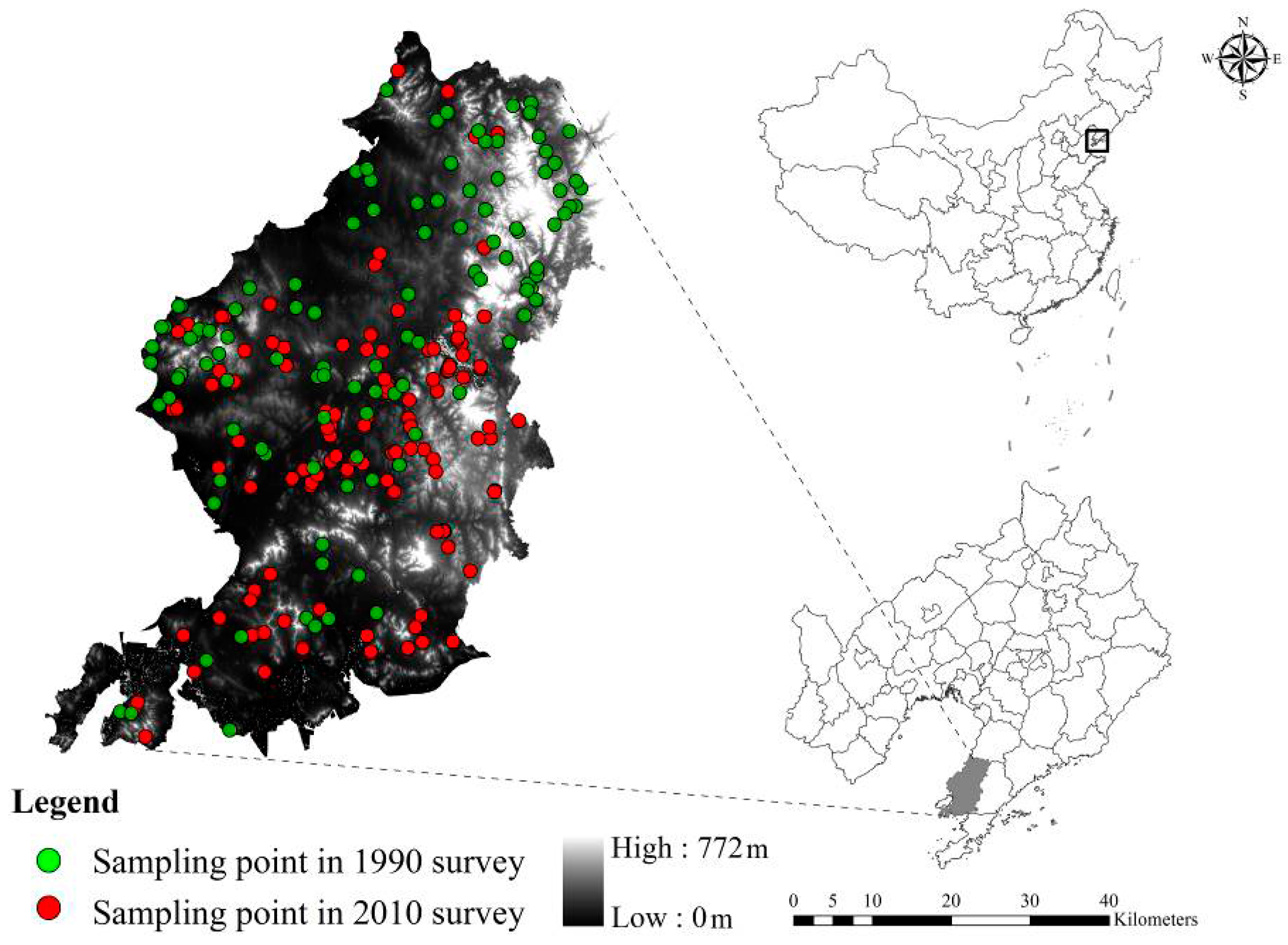
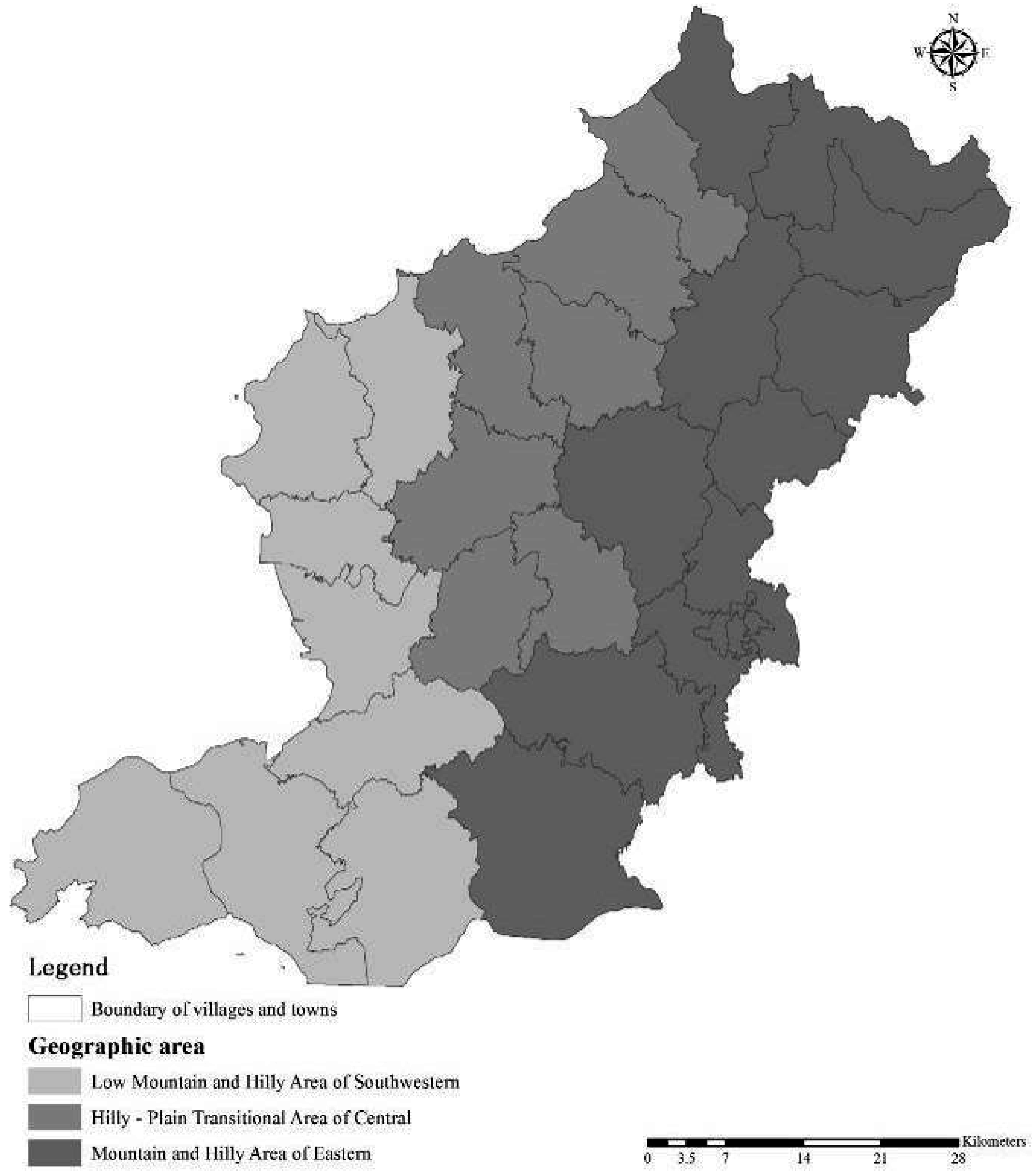

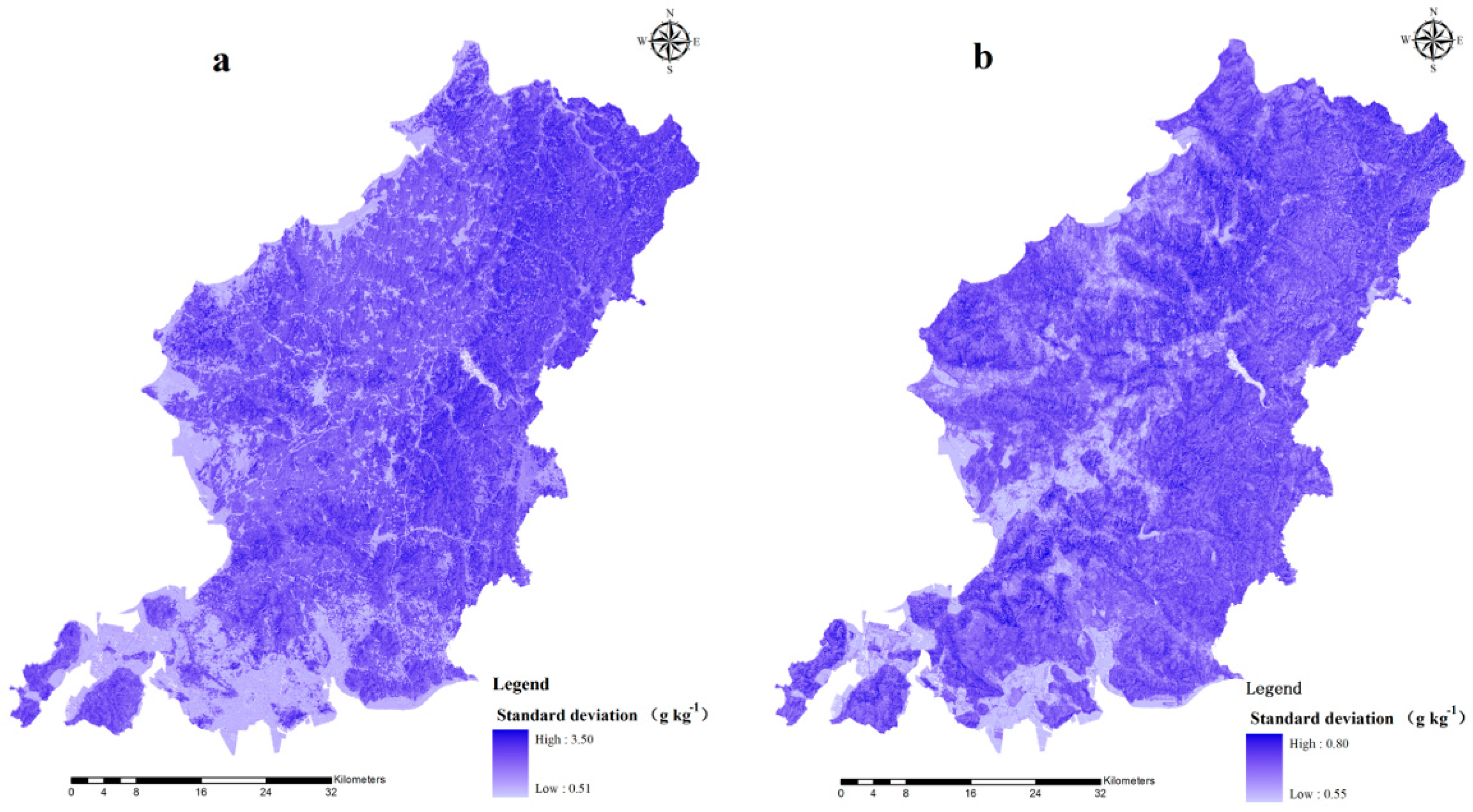
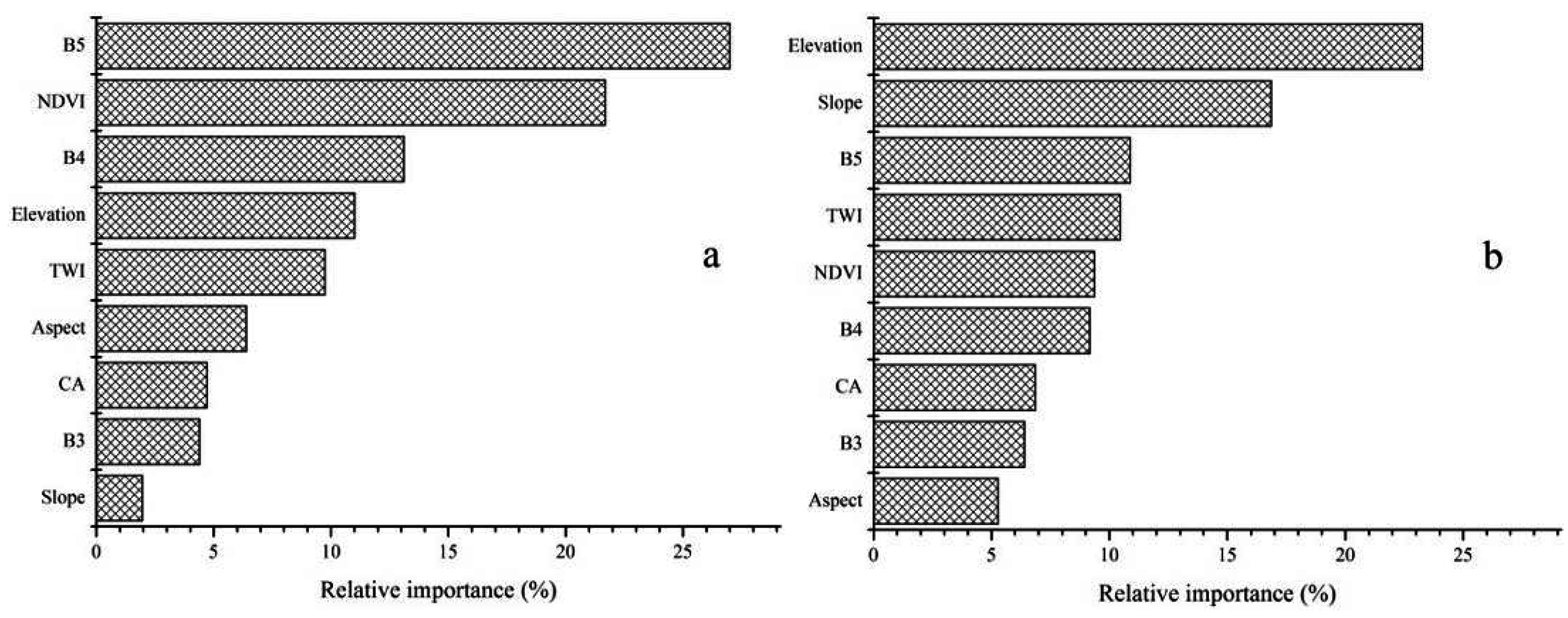

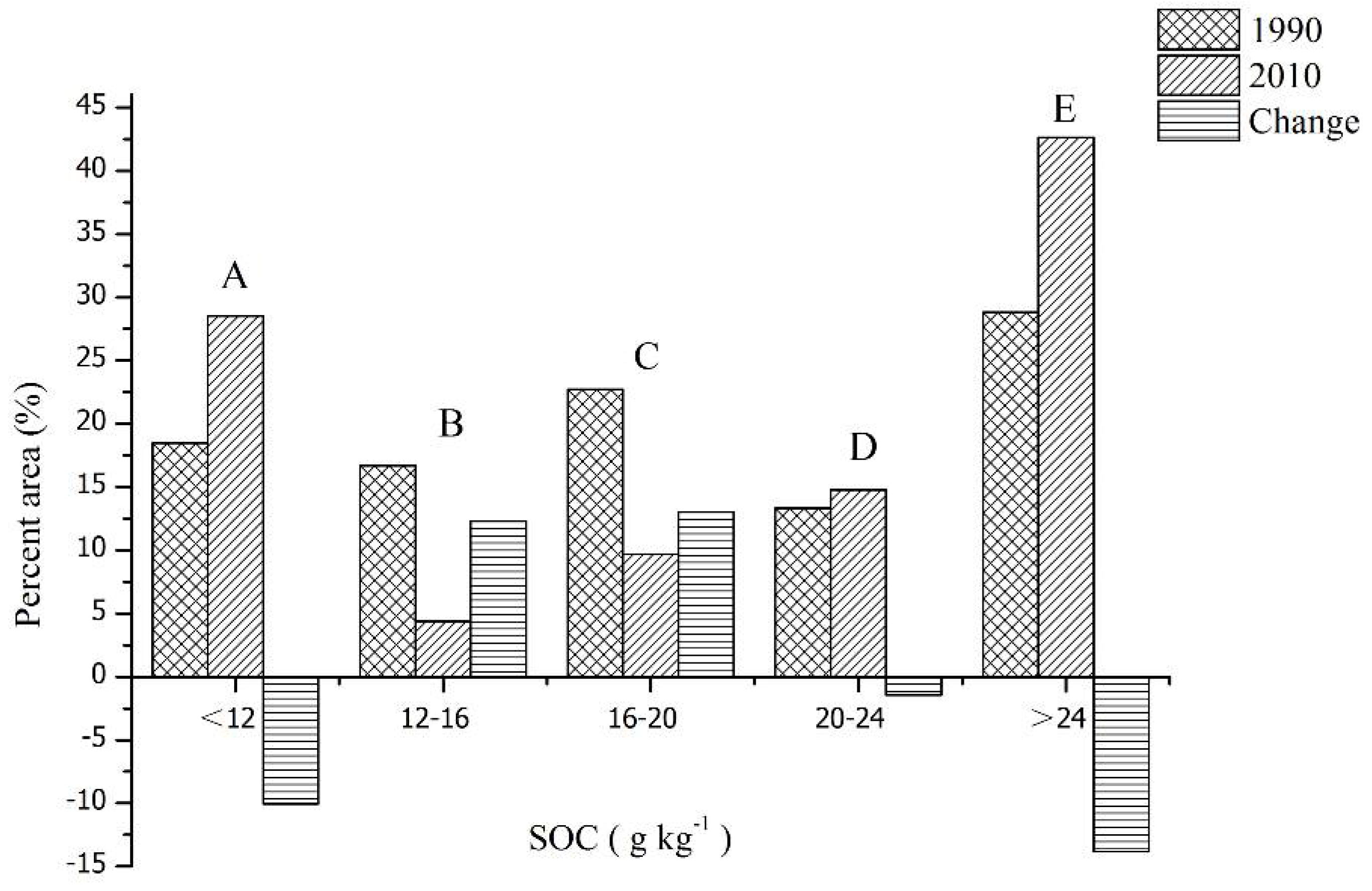
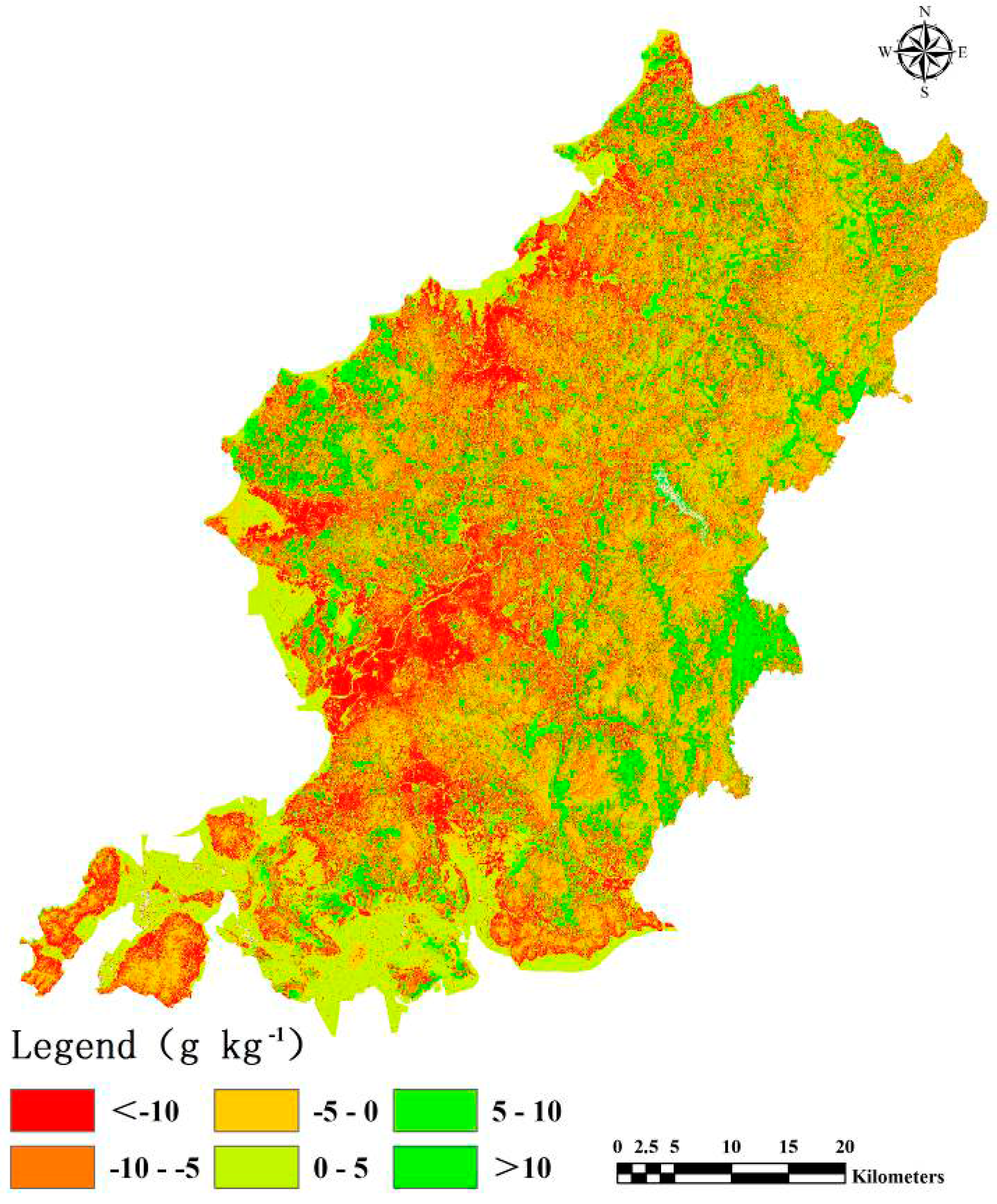
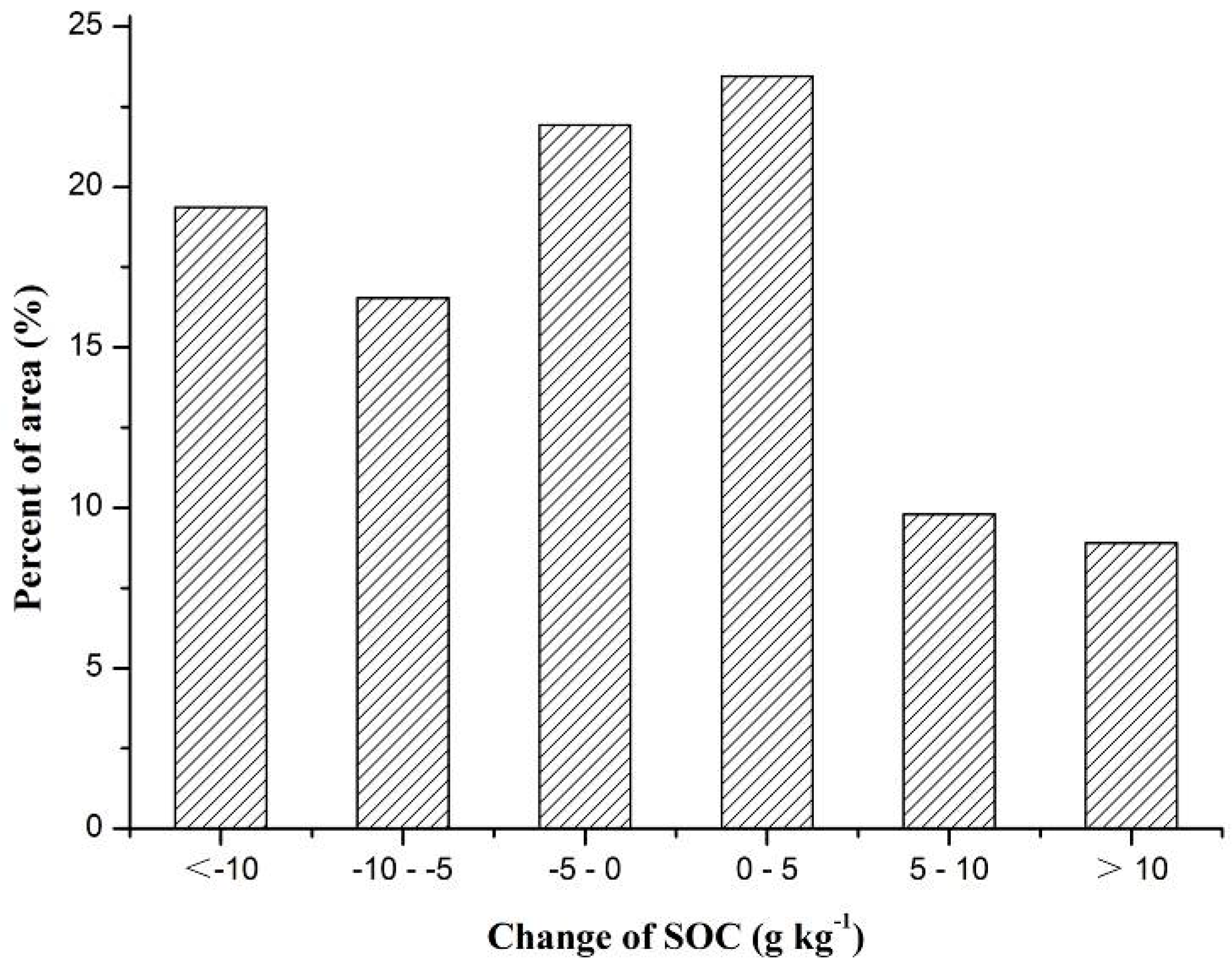
| Years | Land-Use Pattern | Min | Median | Mean | Max | SD | CV (%) |
|---|---|---|---|---|---|---|---|
| 1990 | Cultivated | 1.43 | 7.78 | 12.45 | 46.78 | 11.35 | 91.12 |
| Grassland | 0.95 | 17.32 | 19.30 | 62.11 | 14.54 | 75.32 | |
| Forest | 1.65 | 17.60 | 21.74 | 62.11 | 14.55 | 66.92 | |
| 2010 | Cultivated | 2.38 | 10.99 | 10.00 | 18.76 | 4.22 | 42.25 |
| Grassland | 7.18 | 18.68 | 19.27 | 33.98 | 7.18 | 37.27 | |
| Forest | 12.62 | 22.49 | 22.13 | 32.35 | 5.54 | 25.04 |
| Geographic Area | 1990 SOC (g∙kg−1) | 2010 SOC (g∙kg−1) | SOC Change (g∙kg−1) | ||||
|---|---|---|---|---|---|---|---|
| Count | Range | Mean ± SD | Count | Range | Mean ± SD | ||
| Low Mountain and Hilly Area of the Southwest | 37 | 3.05–62.11 | 16.56 ± 14.87 | 37 | 8.04–33.25 | 16.08 ± 6.91 | −0.48 |
| Hilly–Plain Transitional Area of Central | 25 | 2.35–36.02 | 16.59 ± 8.78 | 36 | 2.38–33.98 | 12.8 ± 6.69 | −3.79 |
| Mountain and Hilly Area of Eastern | 48 | 0.95–61.99 | 25.15 ± 15.15 | 54 | 10.24–33.8 | 22.31 ± 6.14 | −2.84 |
| Property | SOC | Elevation | Slope Aspect | Slope Gradient | TWI | CA | B3 | B4 | B5 |
|---|---|---|---|---|---|---|---|---|---|
| 1990 | |||||||||
| Elevation | 0.37 ** | ||||||||
| Slope aspect | 0.07 | 0.10 | |||||||
| Slope gradient | 0.22 * | 0.63 ** | 0.13 | ||||||
| TWI | −0.24 * | −0.61 ** | −0.44 ** | −0.72 ** | |||||
| CA | 0.14 | 0.16 | 0.11 | 0.15 | −0.34 ** | ||||
| B3 | −0.30 ** | −0.31 ** | 0.03 | −0.35 ** | 0.31** | −0.15 | |||
| B4 | 0.30 ** | 0.07 | 0.05 | −0.18 | 0.06 | −0.02 | 0.32 ** | ||
| B5 | −0.28 ** | −0.20 * | 0.03 | −0.21 * | 0.12 | −0.02 | 0.77 ** | 0.19 * | |
| NDVI | 0.53 ** | 0.42 ** | −0.01 | 0.17 | −0.25 ** | 0.12 | −0.38 ** | 0.62 ** | −0.24 * |
| 2010 | |||||||||
| Elevation | 0.73 ** | ||||||||
| Slope aspect | −0.03 | 0.00 | |||||||
| Slope gradient | 0.48 ** | 0.59 ** | 0.24 ** | ||||||
| TWI | 0.24 ** | 0.22 * | 0.25 ** | 0.36 ** | |||||
| CA | −0.53 ** | −0.57 ** | −0.22 * | −0.77 ** | −0.37 ** | ||||
| B3 | −0.08 | −0.08 | 0.04 | 0.14 | 0.14 | −0.15 | |||
| B4 | −0.07 | −0.03 | −0.05 | 0.10 | 0.11 | −0.11 | 0.60 ** | ||
| B5 | 0.05 | −0.05 | 0.01 | 0.16 | 0.12 | −0.22 * | 0.59 ** | 0.05 | |
| NDVI | −0.12 | −0.04 | −0.06 | −0.10 | −0.13 | 0.11 | −0.62 ** | −0.02 | −0.51 ** |
| Year | Index | Min | Median | Mean | Max | SD |
|---|---|---|---|---|---|---|
| 1990 | MAE | 6.60 | 6.75 | 6.75 | 7.05 | 0.14 |
| RMSE | 9.46 | 9.69 | 9.74 | 10.24 | 0.24 | |
| R2 | 0.43 | 0.54 | 0.53 | 0.61 | 0.06 | |
| LCCC | 0.65 | 0.70 | 0.70 | 0.72 | 0.03 | |
| 2010 | MAE | 4.01 | 4.05 | 4.07 | 4.19 | 0.07 |
| RMSE | 5.14 | 5.22 | 5.26 | 5.42 | 0.09 | |
| R2 | 0.49 | 0.55 | 0.55 | 0.59 | 0.03 | |
| LCCC | 0.66 | 0.70 | 0.69 | 0.71 | 0.02 |
| Land-Use Change | Change Range (g∙kg−1) | Mean ± SD |
|---|---|---|
| Cultivation–Cultivation (C–C) | −29.6 to 20.2 | −2.6 ± 9.3 |
| Cultivation–Forest (C–F) | −27.0 to 18.9 | −1.6 ± 8.5 |
| Cultivation–Grassland (C–G) | −24.0 to 18.9 | −1.8 ± 9.7 |
| Grassland–Grassland (G–G) | −23.0 to 18.9 | −1.2 ± 7.9 |
| Grassland–Cultivation (G–C) | −29.5 to 20.2 | −3.6 ± 9.2 |
| Grassland–Forest (G–F) | −26.5 to 19.7 | −2.3 ± 8.7 |
| Forest–Forest (F–F) | −28.7 to 20.3 | −2.6 ± 9.0 |
| Forest–Grassland (F–G) | −17.6 to 15.2 | −1.6 ± 8.0 |
| Forest–Cultivation (F–C) | −19.6 to 19.1 | −2.5 ± 9.7 |
© 2016 by the authors; licensee MDPI, Basel, Switzerland. This article is an open access article distributed under the terms and conditions of the Creative Commons Attribution (CC-BY) license (http://creativecommons.org/licenses/by/4.0/).
Share and Cite
Wang, S.; Wang, Q.; Adhikari, K.; Jia, S.; Jin, X.; Liu, H. Spatial-Temporal Changes of Soil Organic Carbon Content in Wafangdian, China. Sustainability 2016, 8, 1154. https://doi.org/10.3390/su8111154
Wang S, Wang Q, Adhikari K, Jia S, Jin X, Liu H. Spatial-Temporal Changes of Soil Organic Carbon Content in Wafangdian, China. Sustainability. 2016; 8(11):1154. https://doi.org/10.3390/su8111154
Chicago/Turabian StyleWang, Shuai, Qiubing Wang, Kabindra Adhikari, Shuhai Jia, Xinxin Jin, and Hongbin Liu. 2016. "Spatial-Temporal Changes of Soil Organic Carbon Content in Wafangdian, China" Sustainability 8, no. 11: 1154. https://doi.org/10.3390/su8111154





